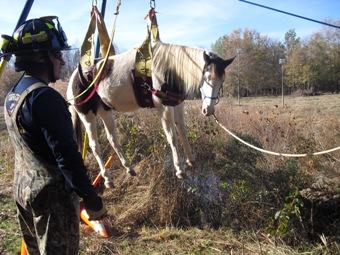
Section Branding
Header Content
Farm Teaches Large Animal Rescue
Primary Content

Under federal law, states must have evacuation plans not only for people, but also for animals. Hurricane Katrina prompted then-President George Bush to sign the, “Pets Evacuation and Transportation Standards Act” in 2006. That’s because so many people fleeing the storm damage were forced to leave animals behind. Now a first-of-its-kind facility is open in Middle Georgia where the focus is on the beasts of the field.
A 700-pound horse is suspended several feet in the air supported by two slings. Thomas and Rebecca Gimenez call out directions to emergency workers as they maneuver the animal out of a ditch.
“Are you ready? Go ahead…pull slowly… a nice smooth haul. That tends to not stimulate the animal.”
An 18-foot metal frame supports the weight of the brown and white spotted filly as first responders coordinate a system of pulleys, moving the horse slowly to stable ground.
“Give us some slack…let it come…keep coming…release….good girl.”
Ariel, a seven year-old Paint Filly heads for the pasture the moment she is free. The rescue is a success, but it’s not real. It’s part of three days of hands-on training at the new five acre Technical Large Animal Emergency Rescue Center in Monroe County. It’s the only facility of its kind in the United States.
Owner and animal expert Rebecca Gimenez travels the country training rescue personnel. Some of that training has to do with geography. Wildfire rescues are common out west, while hurricanes are a threat to livestock on the east coast. She says working with live animals, rather than mannequins, is ideal.
“A live horse gives you the opportunity for the horse to have an opinion. And it breathes. People take these evolutions much more seriously because they see that the animal's breathing, the animal might be excited. The animal reacts.”
The center has multiple stations that simulate real life situations like; overturned trailers, burning barns, and muddy ravines. Trainer and retired veterinarian Thomas Gimenez says one of their animals is particularly well-suited for teaching people how to get animals out of the road.
“The llama is a very good animal for that because they are not friendly. They don’t want to be touched. They are very hard to catch and they are actually smarter than a horse.”
But most of the training animals are horses. And that’s a good thing for a group of firefighters from the City of Milton in Fulton County. The affluent community is home to dozens of horse farms. Battalion Chief Roth Hutcheson says two years ago they formed a large animal rescue team and deployments are common.
“The floor came out of the trailer and the horse actually went through it. We had another one where a horse slid down a bank into a creek, got his feet up under some roots and then a lot of the calls we get are to go into a barn and get a horse up that’s actually down up against a stall wall and they can’t lift it.”
Hutcheson, says working with the live animals makes the demo rescues seem real.
Thomas Gimenez watches as his students prepare to tip over a trailer, one of the most common scenarios in animal rescue. He says keeping the rescuers safe is paramount.
“The biggest goal of this training is to show people, emergency responders, horse owners, how to safely help a large animal that is in some kind of predicament without hurting the animal, without killing the animal, and without hurting or killing a human.”
Thomas says while they will continue traveling the country training rescue personnel, many of their students will now come here to this facility where people and animals do the teaching.
Tags: Technical Large Animal Emergency Rescue Center, Large animal rescue, Rebecca Gimenez, Thomas Gimenez, Milton City Fire Department, horse rescue
